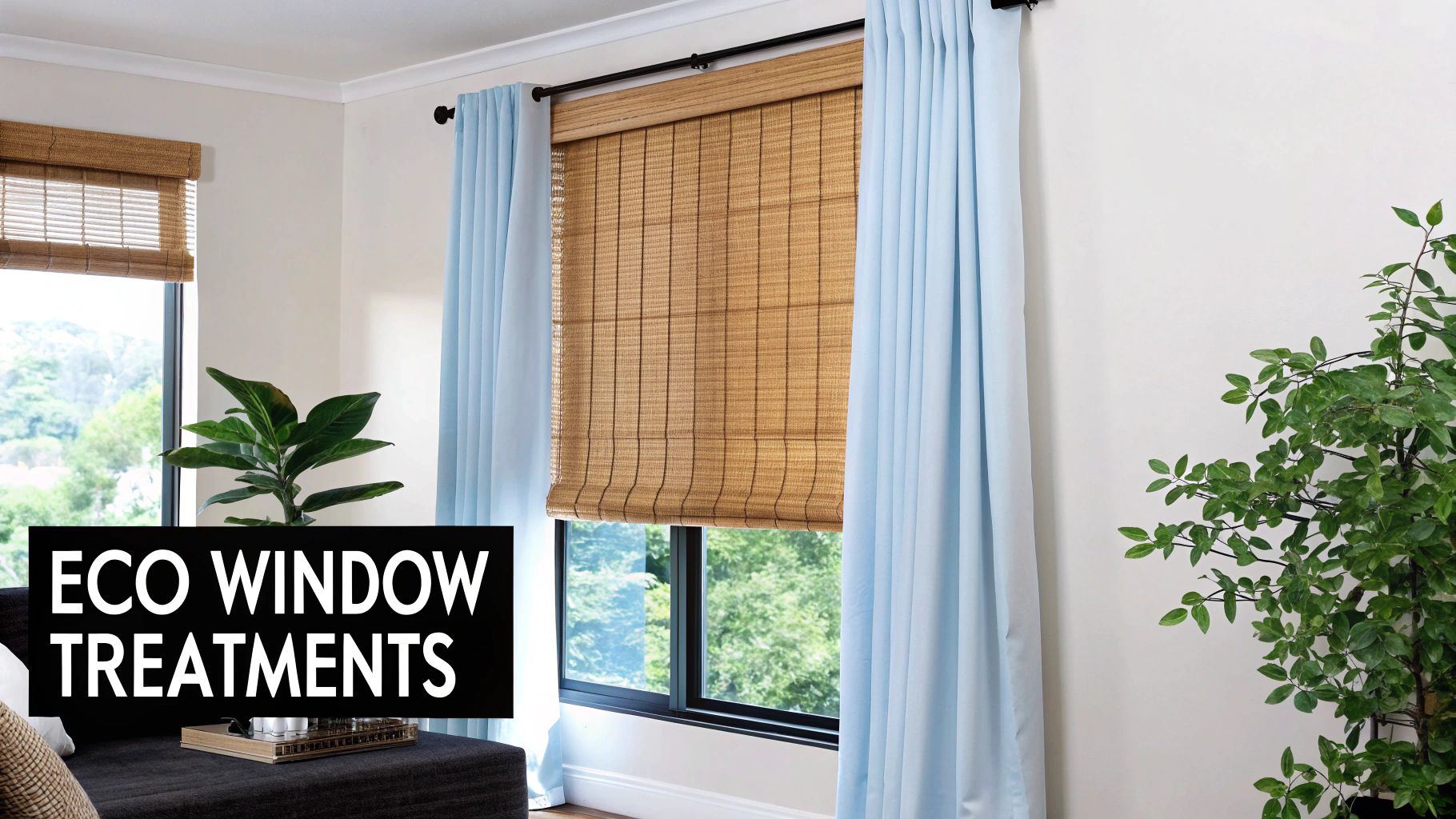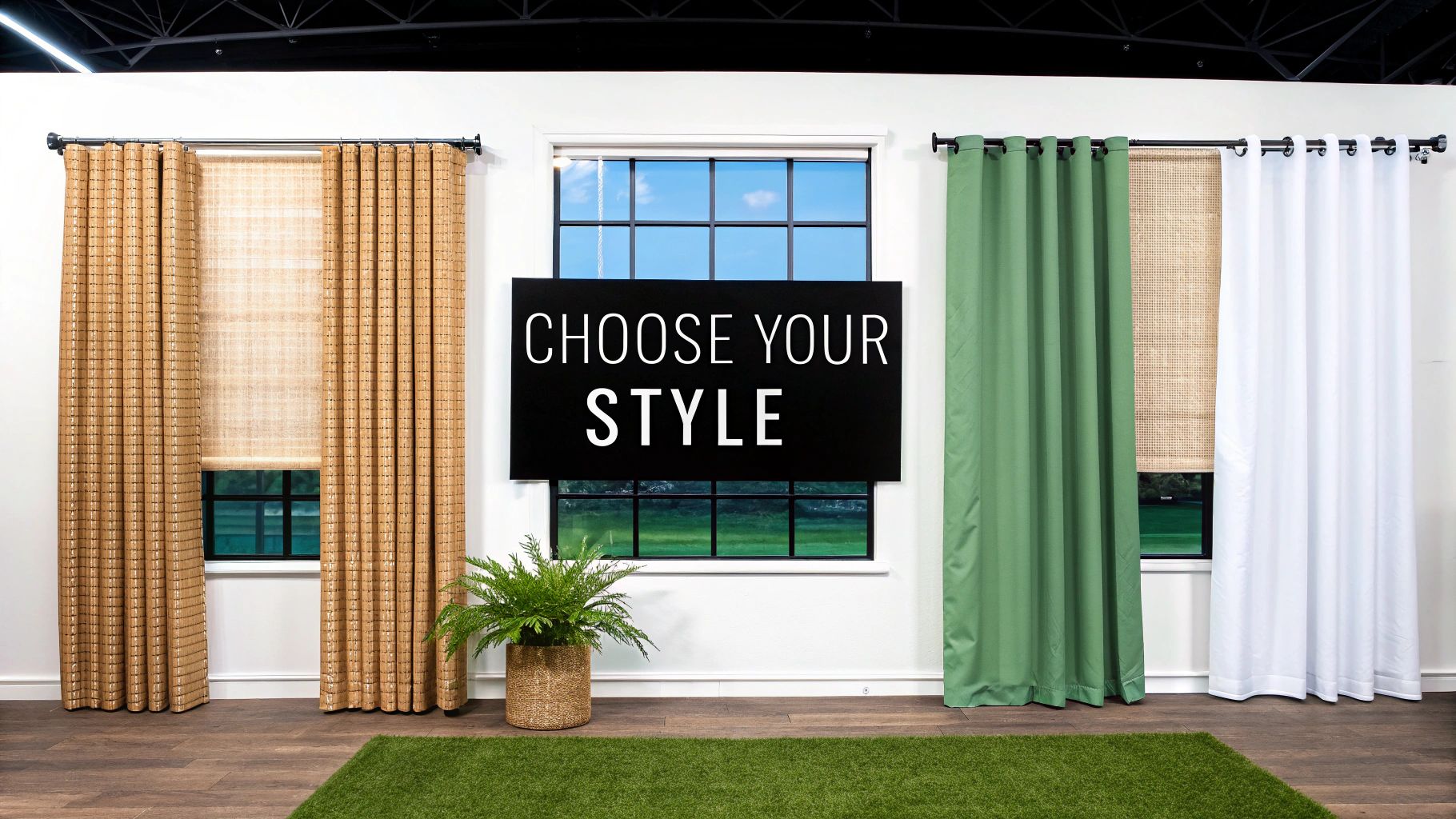
The Ultimate Guide to Eco-Friendly Window Treatments for Your Home
Eco-friendly window treatments are so much more than just stylish coverings for your windows. They’re a thoughtful choice, made from sustainable materials and designed to improve your home's energy efficiency. Think of them not just as decor, but as a smart investment in a healthier planet and a more comfortable living space.
Choosing the right eco-friendly window treatments is a key step in creating a sustainable home. In this guide, we'll walk you through everything you need to know, from the best materials to how they can slash your energy bills.
Table of Contents
- What Are Eco-Friendly Window Treatments?
- Choosing the Best Sustainable Materials
- How Window Treatments Boost Home Energy Efficiency
- Finding an Eco-Friendly Style That Fits Your Home
- How to Care for Your Eco-Friendly Window Treatments
- Frequently Asked Questions
What Are Eco-Friendly Window Treatments?

So, what exactly elevates a simple blind or curtain into the "eco-friendly" category? The short answer is: it's a combination of sustainable materials, energy-efficient design, and non-toxic production.
This approach looks at the entire journey of the product, from the raw materials used to create it all the way to its end-of-life disposal. It’s a complete, holistic view that puts sustainability first at every step.
More Than Just Green Materials
While using sustainable materials like bamboo or recycled fabrics is a huge part of the story, a truly "green" product has to check several boxes. This ensures it’s good for both the planet and your family's health.
To give you a clearer picture, here’s a quick rundown of the core components that make a window treatment truly eco-friendly.
Key Characteristics of Eco-Friendly Window Treatments
This table breaks down what to look for when you're shopping for sustainable options.
| Characteristic | What It Means for Your Home | Common Examples |
|---|---|---|
| Sustainable Sourcing | Materials are renewable, recycled, or from responsibly managed sources, reducing your home's environmental footprint. | Bamboo, jute, linen, recycled polyester, FSC-certified wood. |
| Energy Efficiency | Helps insulate your windows, which means less work for your heater and air conditioner. This leads to lower energy bills. | Cellular shades, thermal-lined curtains, thick woven wood shades. |
| Non-Toxic Production | Made without harsh chemicals or volatile organic compounds (VOCs), leading to better indoor air quality. | Natural, undyed fabrics; products with GREENGUARD Gold certification. |
| Durability & Longevity | Built to last, so you won't need to replace them often. This reduces landfill waste and saves you money over time. | High-quality wood blinds, well-made fabric shades. |
This shift toward sustainability is making waves in the home decor world. The global market for blinds and shades was valued at USD 14.82 billion in 2024 and is expected to grow significantly, driven by consumer demand for energy-efficient options. You can read the full research about the window coverings market to see just how big this trend is.
The core idea is simple: select window coverings that serve a dual purpose. They should not only beautify your space but also contribute positively to a healthier home and planet.
Ultimately, opting for eco-friendly window treatments is a smart investment in your home’s comfort, your carbon footprint, and a more responsible manufacturing industry. It’s a choice that looks good, feels good, and does good.
Choosing the Best Sustainable Materials
The heart of any truly eco-friendly window treatment is the material it's made from. Choosing materials grown or created with the planet in mind is a decision that benefits your home and the environment in equal measure.
These materials do more than just look good; they tell a story of responsible sourcing and thoughtful production. From fast-growing grasses to innovative recycled fabrics, each one brings a unique blend of style, function, and sustainability to your windows.
Rapidly Renewable Resources
Some of the most popular sustainable materials are superstars when it comes to speedy growth. These plants mature in a fraction of the time it takes for traditional hardwoods, making them an excellent renewable choice.
- Bamboo: A true champion of sustainability, bamboo can mature in just 3–5 years. It regenerates from its own roots, needs no pesticides, and adds a warm, natural texture to any room.
- Jute and Hemp: These rugged fibers are known for their durability and minimal environmental impact. They grow quickly with little water and even enrich the soil they grow in, making them a fantastic choice for woven wood shades.
These options connect your home to the natural world, offering an organic aesthetic that’s hard to replicate. You can learn more about how these fit into a larger green design strategy by exploring our guide on sustainable interior design materials.
Recycled and Upcycled Innovations
Sustainability isn't just about growing new things—it's also about cleverly reusing what we already have. This is where the circular economy comes in, transforming materials once considered waste into beautiful, high-performance textiles for your home.
This forward-thinking approach gives materials a second chance. Manufacturers are increasingly turning to recycled plastics (like PET from water bottles) to create stunning blinds and shades that are both durable and stylish.
By choosing products made from recycled content, you directly contribute to reducing landfill waste and conserving the energy needed to produce virgin materials. It's a powerful way to vote for a cleaner planet with your purchase.
For a deeper dive into all the material options out there, consulting a comprehensive a guide to sustainable fabrics can be incredibly helpful, as it often highlights great alternatives like certified organic cotton and wool.
How Window Treatments Boost Home Energy Efficiency
Eco-friendly window treatments do so much more than just look good—they're a smart, hardworking investment in making your home more energy-efficient. They act as a shield, deflecting the sun’s harsh rays in the summer and trapping precious heat inside when the weather turns cold.
This dual-action performance has a direct impact on your comfort and your wallet. By creating an insulating barrier, these coverings reduce the strain on your heating and cooling systems, which are often the biggest energy users in any home.
The Science of Savings: How They Work
How exactly do they pull this off? It all comes down to thermal resistance. Simply put, certain designs and materials are exceptionally good at slowing down the transfer of heat.
Treatments like cellular shades, with their unique honeycomb-shaped pockets, are masters at this. They trap air inside those pockets, creating an insulating layer that keeps outdoor temperatures from seeping in and your comfortable indoor air from escaping. Check out our guide on insulated and thermal curtains to dive deeper into how they work.

The impact here is significant. The U.S. Department of Energy estimates that the right energy-efficient window treatments can reduce heat loss through windows by up to 25% in the winter and reduce heat gain by up to 77% in the summer.
A Year-Round Benefit
This isn't just a seasonal advantage. The savings and comfort add up all year long.
- In Summer: They reflect solar heat, cutting down on heat gain. That means your air conditioner doesn't have to work as hard, lowering your electricity bills.
- In Winter: They provide an extra layer of insulation, preventing heat from escaping through the glass. This helps keep your home cozy while dialing back your heating costs.
Comparing Energy Efficient Window Treatments
| Treatment Type | Primary Function | Potential Energy Savings | Best For |
|---|---|---|---|
| Cellular Shades | Insulation via air pockets | Up to 20% | All-season insulation, especially in extreme climates. |
| Thermal Curtains | Insulation via layered fabric | Up to 25% | Bedrooms and living rooms needing heat retention in winter. |
| Solar Shades | Heat & UV ray reflection | Up to 15% | Sunny rooms where glare reduction is needed without blocking the view. |
| Roman Shades | Insulation (when lined) | Up to 12% | Decorative spaces where style and moderate insulation are both priorities. |
| Wood Shutters | Air barrier creation | Up to 10% | Creating a solid barrier in traditional or classic home designs. |
The bottom line is that choosing the right eco-friendly window treatments is one of the simplest yet most effective ways to lower your carbon footprint and save money. It's a win for your home and a win for the planet.
For more ways to save, combine these treatments with other practical home energy efficiency tips to create a truly green household.
Finding an Eco-Friendly Style That Fits Your Home
Let's clear up a common myth: choosing eco-friendly window treatments does not mean you have to sacrifice style. In fact, it’s quite the opposite. Sustainable materials often bring a unique warmth, texture, and character to a room that mass-produced synthetics just can't replicate.
Think of this as your visual guide to some of the most beautiful and popular sustainable options out there. We’ll explore how these different styles can elevate your space while keeping your home's decor green and gorgeous.

For a Warm and Natural Look
If you're aiming for an organic, earthy vibe, materials sourced directly from nature are your best friend. They create a seamless connection between your indoor space and the outdoors, fostering a calming, grounded atmosphere.
- Bamboo & Woven Wood Shades: These are superstars of natural decor. Materials like bamboo, jute, and grasses are woven together to create shades that gently filter light, casting a warm, inviting glow.
- FSC-Certified Wood Blinds: For a more classic and structured look, nothing beats real wood. When you choose blinds with a Forest Stewardship Council (FSC) certification, you can rest easy knowing the wood was harvested responsibly.
For a Soft and Elegant Feel
If your personal style leans more towards soft, flowing, and sophisticated, sustainable fabrics open up a world of possibilities. They can soften the hard edges in a room and add a layer of luxurious texture.
- Organic Cotton & Linen Curtains: These classic fabrics are breathable, beautiful, and get softer with time. Their natural drape creates an effortless elegance perfect for bedrooms and formal dining areas.
- Recycled Fabric Drapes: Made from materials like recycled plastic bottles (PET), these modern textiles are surprisingly soft and durable. They prove that sustainability can be incredibly versatile and chic.
For a Modern and Minimalist Vibe
For those who prefer clean lines and high-performance design, several eco-friendly options fit a contemporary aesthetic perfectly. These styles put function first without compromising on their green credentials.
Cellular shades are a prime example. Their crisp, pleated look offers a tidy, uncluttered appearance that works beautifully in minimalist and modern spaces. Their energy-saving honeycomb structure is a brilliant fusion of form and function.
This approach—where sustainability is woven into every aspect of your living space—is a cornerstone of modern green living. For more ideas on how to expand this philosophy, check out our guide to eco-friendly home decor.
How to Care for Your Eco-Friendly Window Treatments
A truly sustainable product isn’t just about how it’s made; it’s about how long it lasts. Taking proper care of your eco-friendly window treatments keeps them looking fantastic and extends their life, which is a win for both your wallet and the planet. A little maintenance goes a very long way.
Simple Cleaning for a Long Life
The great thing about most sustainable materials is that they're surprisingly easy to look after. The one hard rule? No harsh chemicals. They can damage natural fibers and defeat the purpose of choosing a non-toxic product.
Instead, stick with these simple, material-friendly methods:
-
Bamboo and Woven Woods: These just need a regular dusting. Use a soft cloth or the brush attachment on your vacuum. For a minor spot, blot gently with a slightly damp cloth—never soak the material—and let it air dry completely before rolling it up.
-
Organic Cotton and Linen: Most can be machine washed on a gentle cycle with cold water, but always check the manufacturer’s tag first! Hang them to air dry away from direct sunlight to prevent shrinking or fading.
-
Recycled Fabrics: These durable materials are often the easiest to handle. A quick vacuum or a gentle wipe-down with a damp cloth is usually all it takes to keep them looking fresh.
Proper maintenance is the final, crucial step in the lifecycle of a sustainable product. By extending its usability, you honor the resources used to create it and significantly reduce your environmental footprint over time.
Frequently Asked Questions
Jumping into the world of eco-friendly window treatments usually brings up a few questions. We get it. To help you feel completely confident, here are answers to the most common queries we hear from homeowners.
Are eco-friendly window treatments more expensive?
Not necessarily. While some high-end sustainable options have a higher initial cost, many are priced competitively with standard treatments. For example, bamboo shades are often comparable in price to synthetic blinds. Plus, energy-efficient options like cellular shades provide long-term savings on utility bills, making them a smart financial investment over time.
What is the most energy-efficient window treatment?
The most energy-efficient window treatment is the cellular shade, also known as a honeycomb shade. Its unique, honeycomb-shaped pockets trap air, creating a powerful insulating barrier. This design significantly reduces heat transfer, keeping your home cooler in the summer and warmer in the winter, which can lead to substantial savings on your energy bills.
How can I tell if a window treatment is really eco-friendly?
To verify if a window treatment is genuinely eco-friendly, look beyond marketing terms and check for specific, verifiable details. Look for materials that are rapidly renewable (like bamboo or hemp), made from recycled content (like PET fabrics), or have certifications. Key third-party labels to look for include GREENGUARD (for low chemical emissions), OEKO-TEX (for textile safety), and FSC (Forest Stewardship Council) for responsibly sourced wood.
At Joey'z Shopping, we believe a beautiful home and a healthy planet should go hand in hand. Explore our curated collection of stylish, sustainable window treatments to find the perfect blend of form, function, and eco-conscious design for your space. Discover our full range of eco-friendly options today!
